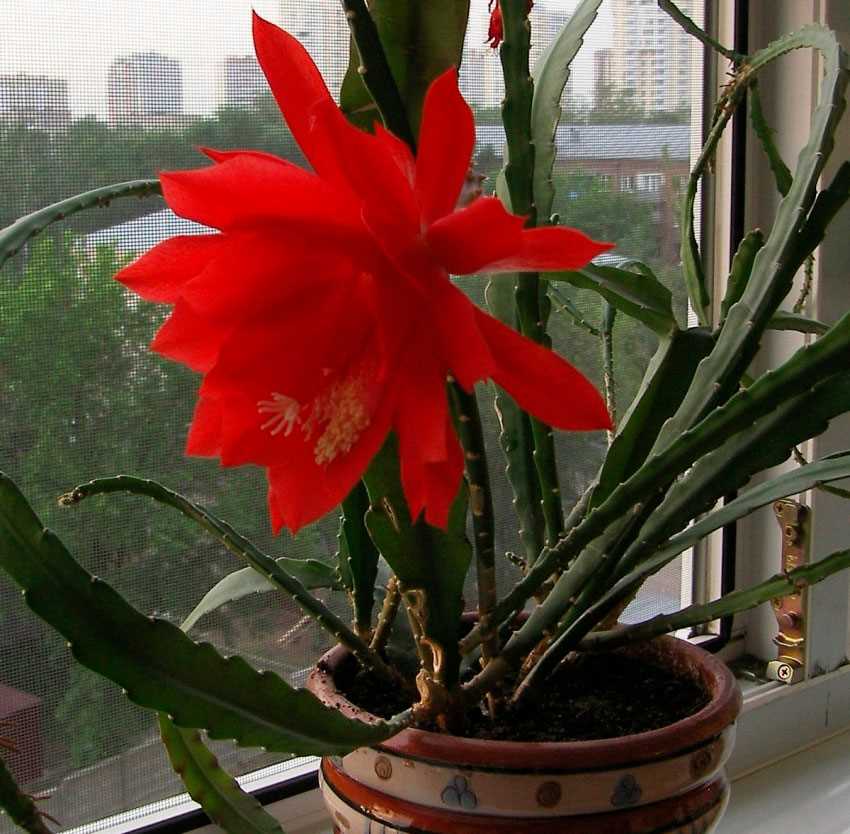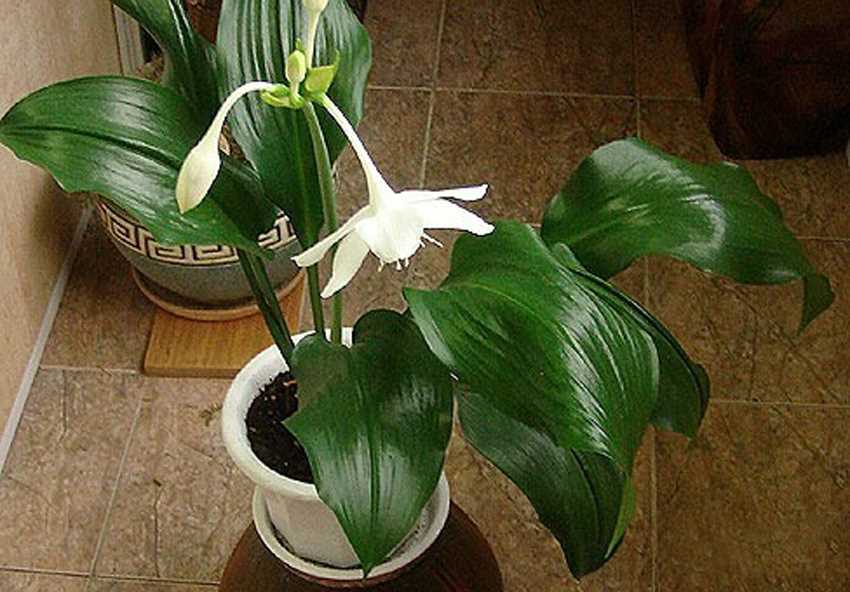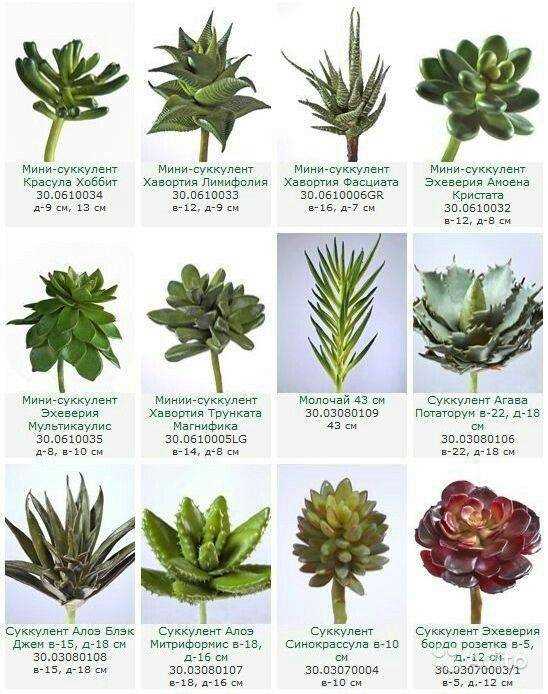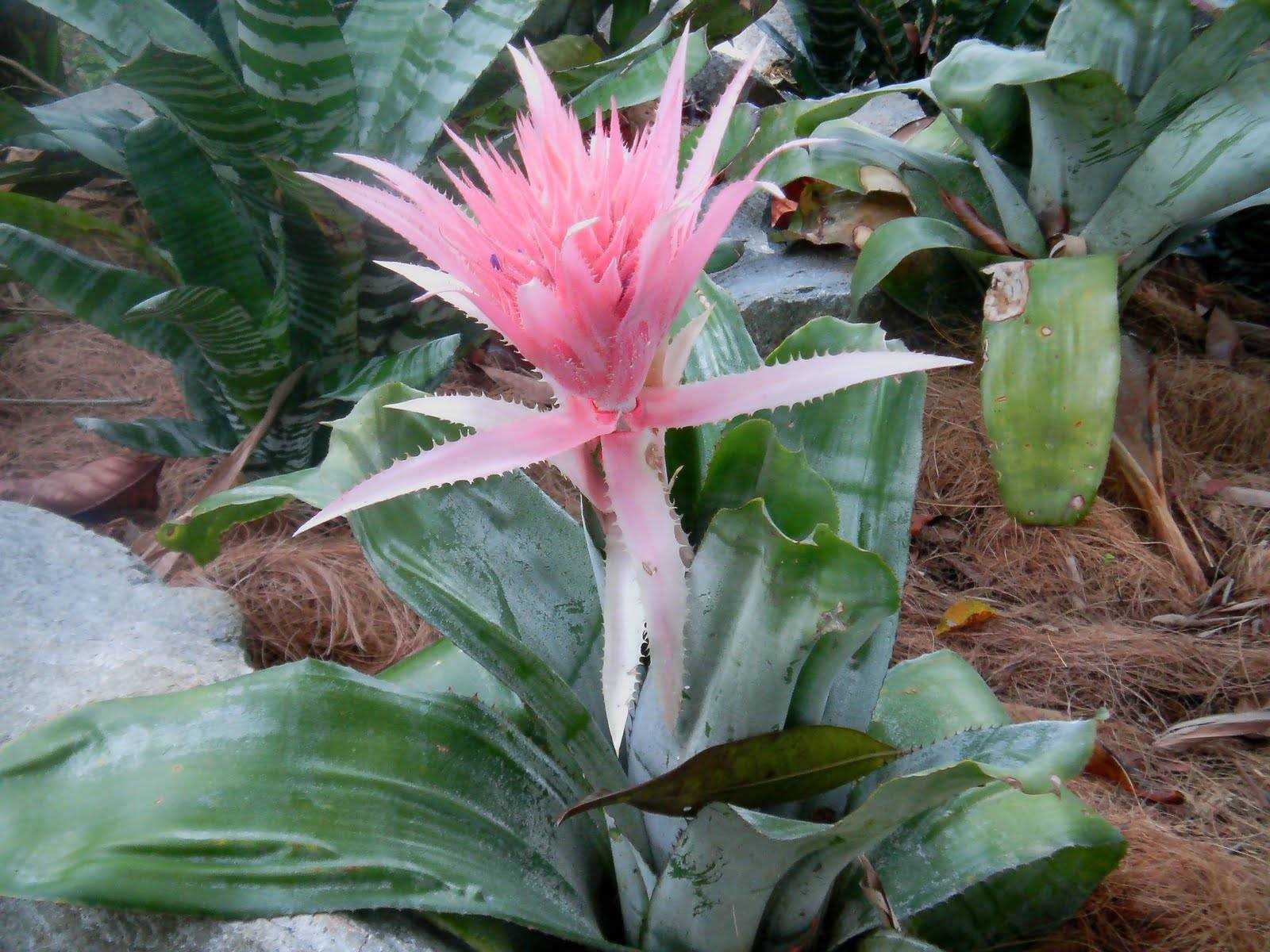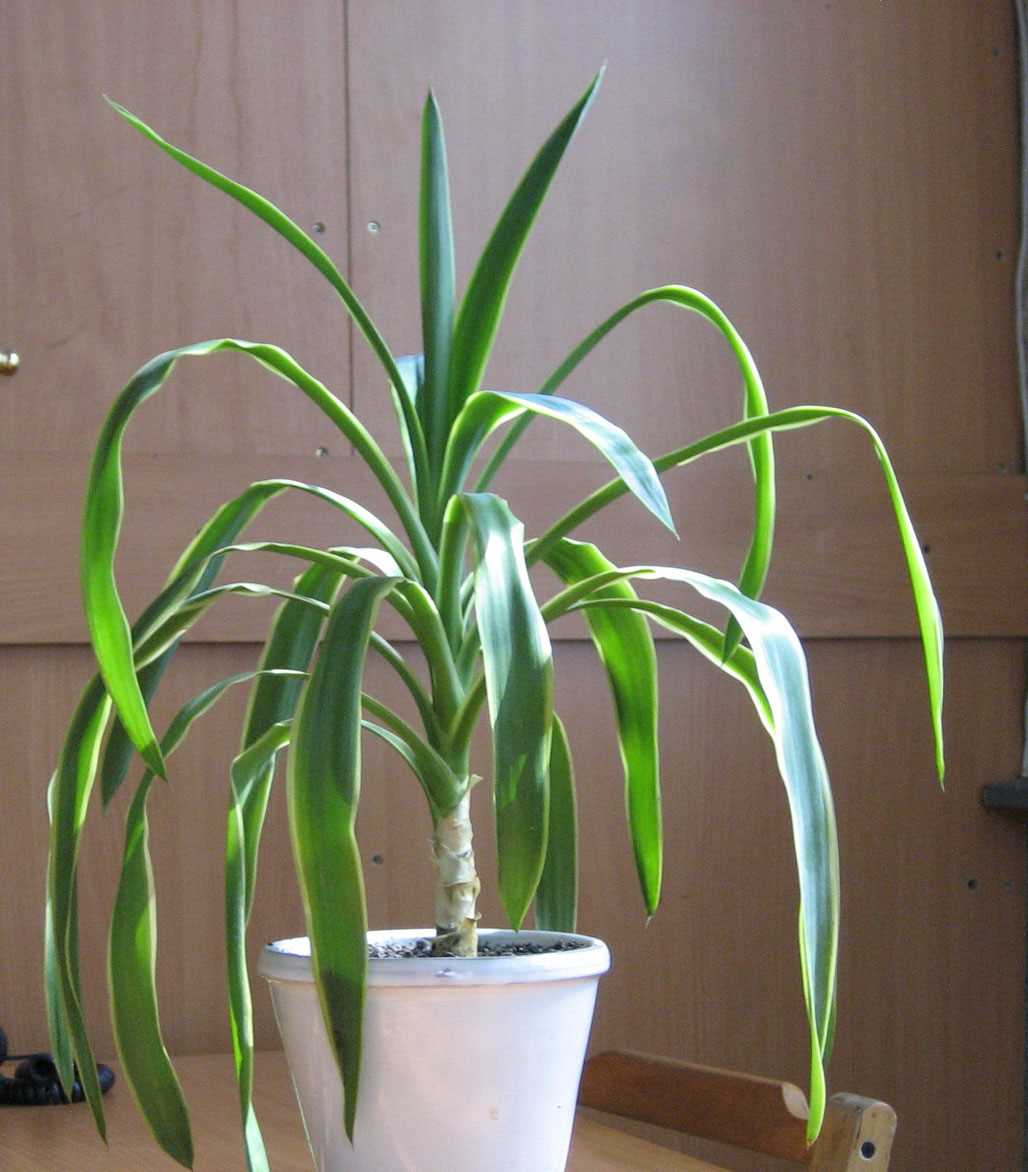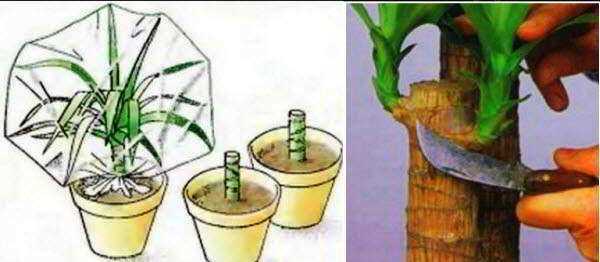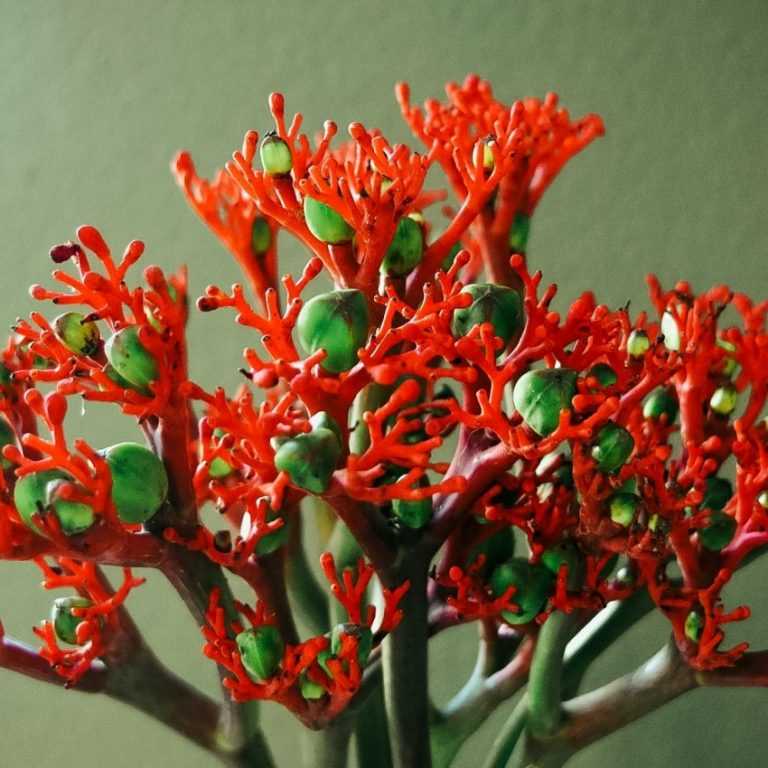- Уход за молодой орхидеей
- Выбор удобрения
- Полив орхидеи
- Важные моменты полива
- 1. Режим полива
- 2. Способ полива
- 3. Вода для полива
- 4. Учет особенностей вида
- Режим полива
- Температура воды для полива
- Дренажная система для полива
- Как выбрать удобрение для орхидеи
- Азотное удобрение для орхидеи
- Фосфорное удобрение для орхидеи
- Калийное удобрение для орхидеи
- Какое удобрение подойдет лучше всего?
- Вопрос-ответ:
- Как часто нужно поливать молодую орхидею?
- Какой режим полива подходит для молодой орхидеи?
- Как выбрать подходящее удобрение для молодой орхидеи?
- Как часто нужно удобрять молодую орхидею?
- Какое удобрение может быть оптимальным для молодой орхидеи?
Орхидеи – это изысканные и нежные растения, которые требуют особого ухода и внимания. И если вы только начинаете заниматься выращиванием этих красивых цветов, то вам стоит ознакомиться с основными принципами ухода за молодой орхидеей. В этой статье вы узнаете, как правильно поливать молодую орхидею и какое удобрение подойдет для ее роста и развития.
Одной из основных задач при уходе за молодой орхидеей является правильное поливание. Важно помнить, что орхидеи не любят избыточную влагу и стоит избегать застоя воды в горшке. Чтобы определить, когда необходимо поливать орхидею, достаточно проверить влажность почвы. Если она ощущается сухой на ощупь – это значит, что растению нужно поливать. Но не стоит поливать орхидею так, чтобы земля в горшке была постоянно влажной, это может привести к гниению корней. Лучше поливать орхидею умеренно, но регулярно, например, раз в неделю в летнее время и раз в две недели в зимний период.
Важной составляющей ухода за молодой орхидеей является подбор правильного удобрения. Орхидеям необходимы определенные микроэлементы для нормального роста и развития. Лучше всего использовать удобрения сбалансированного состава, в которых присутствуют все необходимые растению компоненты. Удобрение следует вносить в почву орхидеи в соответствии с инструкцией на упаковке. Важно помнить, что орхидеи не нуждаются в частом удобрении, поэтому рекомендуется удобрять растение раз в месяц в летнее время и раз в два месяца в зимний период.
Уход за молодой орхидеей
Молодые орхидеи требуют особого ухода для своего здорового роста и развития. Одним из ключевых аспектов является полив растения. Молодые орхидеи нуждаются в регулярном, но не избыточном поливе. Важно следить за состоянием почвы и влажностью, чтобы орхидея не пересыхала и не переувлажнялась.
При поливе молодой орхидеи рекомендуется использовать фильтрованную или дистиллированную воду, чтобы избежать воздействия хлора и других химических веществ на корни растения. Также можно использовать сточную воду из аквариума, предварительно освобожденную от фильтров и химических добавок.
Выбор удобрения
Для молодых орхидей необходимо выбирать специальные удобрения, которые содержат все необходимые для роста и развития растения микроэлементы и минералы. Орхидеям требуются удобрения с повышенным содержанием азота, фосфора и калия.
Одним из популярных и эффективных видов удобрений для молодых орхидей являются специальные растворы с микроэлементами, которые можно приобрести в специализированных магазинах. Такие удобрения позволяют обеспечить орхидею всем необходимым для ее роста и развития, повысить иммунитет и устойчивость к болезням и стрессовым ситуациям.
Важно помнить, что удобрения следует применять с осторожностью и следовать рекомендациям производителя. Переусердство может привести к перегрузке растения минералами и вызвать его увядание или даже гибель. Оптимальным вариантом является удобрение орхидей раз в две недели в период активного роста и один раз в месяц в период покоя.
Полив орхидеи
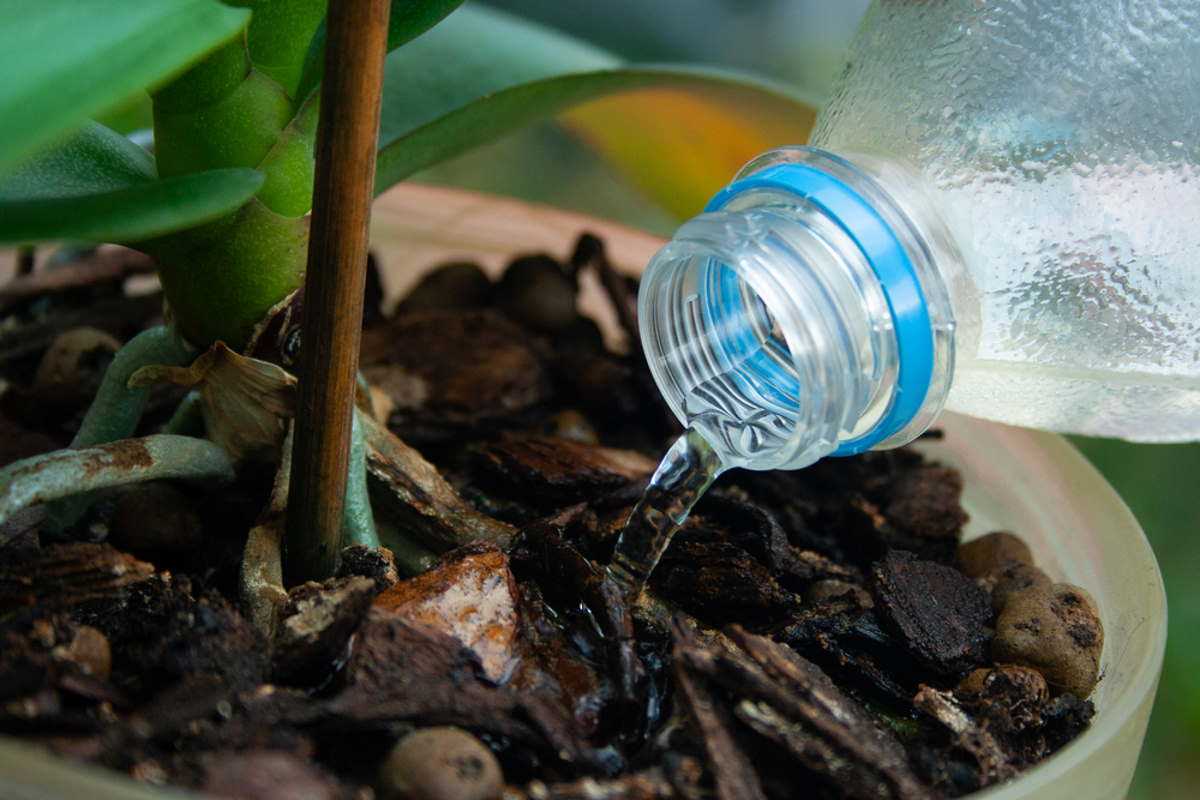
Правильный полив играет важную роль в уходе за молодой орхидеей. Орхидея – это тропическое растение, которое требует особого подхода. Неконтролируемый полив может привести к гниению корней, а пересушка может привести к увяданию растения.
1. Подходящая вода. При поливе орхидеи следует использовать комнатную температуру воды. Качество воды играет также важную роль. Орхидея предпочитает мягкую воду без химических добавок. Если вода в вашем районе жесткая, можно использовать фильтрованную воду или оставить ее на несколько дней для отстоя.
2. Режим полива. Орхидея предпочитает небольшие и регулярные порции воды. Частота полива зависит от фазы роста и условий окружающей среды. Обычно поливают раз в неделю во время активного роста и раз в 2-3 недели в период покоя. Важно не заливать орхидею и не оставлять в стоячей воде.
3. Метод полива. Орхидею можно поливать тремя основными способами: погружая корни в воду на несколько минут, оросить почву тонким струей воды из лейки, или использовать систему капельного полива. Важно, чтобы вода поглощалась всеми корнями растения.
4. Полив в период цветения. Во время цветения орхидею поливают аккуратно, чтобы не попадать на цветки. Лучшим способом полива в этот период является метод орошения почвы или капельного полива, чтобы вода не попадала на цветки и их не повреждала. Также важно уменьшить интенсивность полива во время цветения.
Важные моменты полива
При уходе за молодой орхидеей важно правильно поливать растение. Орхидея – это эпифитное растение, которое привыкло к дождевой воде, падающей с деревьев. При поливе орхидеи нужно учитывать ее особенности.
1. Режим полива
Орхидеи не нужно часто поливать, так как корни растения быстро гниют при пролонгированной влажности. Поливайте орхидею, когда субстрат полностью просохнет. Вы можете проверить влажность субстрата путем внесения пальца на глубину около 2 см. Если субстрат сухой – пора поливать.
2. Способ полива

Поливайте орхидею методом иммерсии. Поставьте горшок с растением в емкость с водой на несколько минут. После этого, слейте лишнюю воду и верните орхидею на место. Этот способ позволяет корням насытиться влагой, исключая их переувлажнение и гниение.
3. Вода для полива
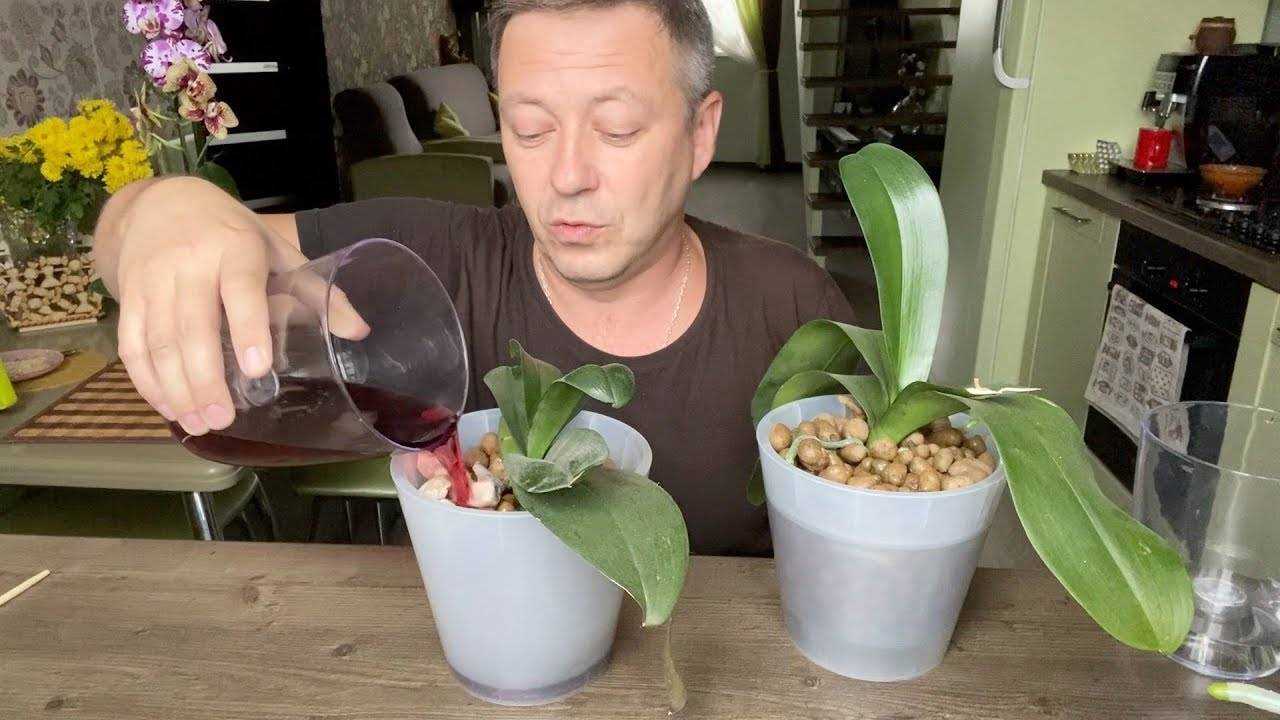
Орхидею поливают исключительно мягкой водой, так как она не переносит излишнюю жесткость и содержание хлора. Если вода в вашем регионе жесткая, рекомендуется использовать фильтрованную или отстоянную воду.
4. Учет особенностей вида
При поливе орхидеи учитывайте конкретные особенности вида. Некоторые орхидеи предпочитают ежедневный полив, в то время как другие могут обходиться поливом раз в несколько недель. Изучите рекомендации по уходу для вашего вида орхидеи.
Режим полива
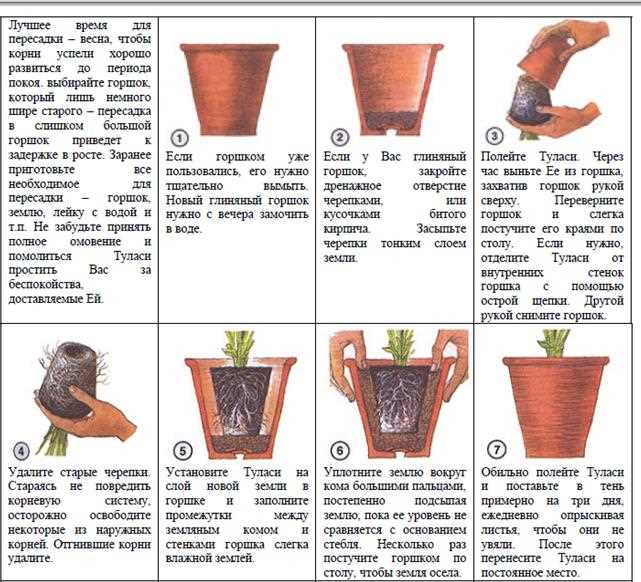
Орхидея – это растение тропического происхождения, поэтому она требует особого режима полива. Полив орхидеи должен быть регулярным, но не слишком частым, чтобы не вызывать гниение корней.
Оптимальный режим полива
Оптимальный режим полива для орхидеи – раз в 7-10 дней. Но необходимо учитывать факторы, такие как температура окружающей среды, влажность воздуха и размер горшка. В жаркую погоду или при низкой влажности полив можно проводить чаще, а в прохладное время года – реже.
Никогда не оставляйте орхидею в стоячей воде!
Орхидеи не выносят избыточную влагу, поэтому исключительно важно дренировать горшок и удалить излишнюю воду после полива. Вода, накопившаяся в поддоне, может привести к разложению корней и гибели растения. Орхидея терпит недостаток воды намного лучше, чем ее избыток.
Расписание полива
Следует создать расписание полива, учитывая некоторые особенности орхидеи. Например, орхидеи с прозрачными горшками требуют чащего полива, так как место произрастания корней более открытое. Орхидеи, выращиваемые в глиняных горшках, могут требовать реже полива, так как глина задерживает влагу. Также, стоит учитывать сезон и стадию развития растения – летом и в период цветения орхидеи нуждаются больше влаги.
Температура воды для полива

Температура воды для полива орхидеи играет важную роль в поддержании здоровья и роста растения. Как правило, идеальная температура воды для полива составляет примерно 20-25 градусов Цельсия.
Использование воды при температуре меньше 20 градусов может вызвать стресс у орхидеи и привести к ослаблению и остановке роста. С другой стороны, использование горячей воды с температурой выше 25 градусов может привести к ожогам корней и плохому поглощению влаги.
Чтобы быть уверенным в правильной температуре воды, можно использовать термометр для измерения температуры воды, которую будете использовать для полива орхидеи.
Это позволит подобрать оптимальную температуру и избежать возможных проблем, связанных с использованием слишком холодной или горячей воды.
Если вода из-под крана слишком холодная или слишком горячая, можно использовать фильтры или специальные контейнеры для накопления воды и последующего ее нагрева или охлаждения до нужной температуры.
Так стоп!!! Вы всё ещё не подписаны на наши каналы в Телеграмм и Дзен? Посмотрите: ТГ - (@historyfantasydetectivechat) и Дзен (https://dzen.ru/myshortsstorys)
Дренажная система для полива
Орхидеи требуют особого подхода к поливу, чтобы избежать гниения корней и потери растения. Одним из ключевых аспектов правильного полива является использование дренажной системы. Дренажное устройство помогает отводить избыток влаги и предотвращает застойную влагу в горшке. Это особенно важно для молодых орхидей, которые более чувствительны к переувлажнению.
Дренажный слой – это первый элемент дренажной системы. Он обычно состоит из гравия или керамзита и помещается на дне горшка перед посадкой растения. Дренажный слой обеспечивает свободное протекание воды и предотвращает ее задержку в корнях орхидеи.
Нижний полив – это способ полива орхидей через дренажный слой. Он заключается в том, чтобы залить горшок с орхидеей водой и дать ей впитаться через отверстия в горшке. Такой метод полива помогает избежать попадания воды на листья и сердцевину растения, что может привести к их гниению.
При выборе дренажного устройства необходимо учитывать особенности орхидей и предпочтения каждого сорта. Некоторые сорта предпочитают более воздушную среду вокруг своих корней, поэтому дренажный слой может потребоваться более грубым и воздушным. Важно помнить, что дренажная система – это необходимый элемент заботы о молодой орхидее, который поможет ей расти и процветать.
Как выбрать удобрение для орхидеи

Орхидеи являются особыми растениями, которые требуют особого ухода. Одним из важных аспектов заботы о ними является правильное питание и удобрение. Важно выбрать подходящее удобрение, которое будет обеспечивать растение всеми необходимыми питательными веществами.
Перед тем, как выбрать удобрение для орхидеи, важно учитывать ее вид и ее потребности. Орхидеи делятся на несколько видов в зависимости от условий их происхождения. Некоторые виды предпочитают сухой климат, другие – влажный. Поэтому важно выбрать удобрение, которое будет соответствовать потребностям конкретного вида орхидеи.
Удобрения для орхидей обычно содержат несколько основных питательных веществ, таких как азот, фосфор и калий. Обратите внимание на баланс этих элементов в удобрении. Для орхидей особенно важен азот, который способствует росту зеленой массы растения. Также стоит обратить внимание на содержание микроэлементов, таких как железо, магний и медь, которые также необходимы для нормального развития орхидей.
Помимо состава, также стоит обратить внимание на форму удобрения. Для орхидей лучше использовать удобрение в жидкой форме, так как они лучше усваивают питательные вещества из жидкой среды. Жидкое удобрение можно добавлять в воду для полива или наносить на листья растения, используя специальный аппликатор.
Азотное удобрение для орхидеи
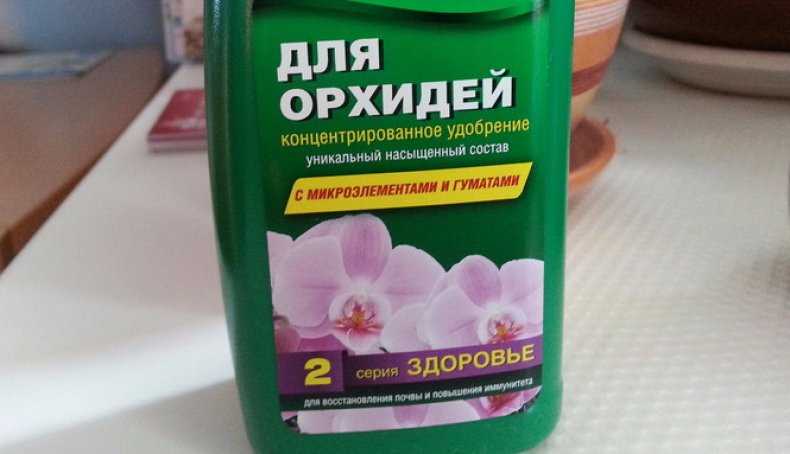
Азотное удобрение является неотъемлемой частью комплексного ухода за молодой орхидеей. Азот – один из основных элементов, необходимых для здорового роста и развития растения. Он влияет на синтез белка, аминокислот и нуклеиновых кислот, обеспечивая энергию для клеток орхидеи.
Выбирая азотное удобрение для орхидеи, важно учитывать его состав и концентрацию. Чаще всего используются удобрения на основе нитратного азота, так как они хорошо растворимы в воде и быстро поступают в растение. Также можно использовать аммиачную форму азота, однако ее необходимо применять с осторожностью, чтобы не вызвать ожоги корней.
Рекомендуется применять азотное удобрение для орхидеи в период активного роста, т.е. весной и летом. Дозировка и частота применения зависят от конкретного удобрения, поэтому следует обратиться к инструкции производителя. Обычно удобрение растворяют в воде и подкармливают растение раз в 2-4 недели.
Не следует злоупотреблять азотными удобрениями, так как чрезмерное количество азота может привести к переувлажнению субстрата и разрыву клеток, а также стимулировать рост листвы в ущерб формированию цветочных бутонов. Важно соблюдать баланс питательных веществ и следить за состоянием растения.
Итак, азотное удобрение – неотъемлемая часть ухода за орхидеей. Правильно выбранное и примененное удобрение обеспечит растению необходимые питательные вещества для здорового и красивого развития. Следует помнить о мере и не злоупотреблять азотом, чтобы не нарушить баланс и не нанести вред растению.
Фосфорное удобрение для орхидеи
Фосфорное удобрение является одним из ключевых компонентов для успешного развития и цветения орхидеи. Фосфор играет важную роль в процессе фотосинтеза и энергетического обмена растения. Он способствует формированию и укреплению корневой системы, улучшает поглощение питательных веществ из почвы.
Оптимальное количество фосфора в почве обеспечивает развитие сильных и здоровых корней, что способствует нормальному росту орхидеи. Недостаток фосфора может привести к ослаблению растения и ухудшению цветения.
Для подкормки орхидеи фосфорными удобрениями можно использовать специализированные комплексы с уровнем фосфора, соответствующим потребностям растения. Важно помнить, что переизбыток фосфора может быть также вреден для растения, поэтому не стоит превышать рекомендуемую дозу.
Фосфорное удобрение для орхидеи можно наносить как корневым образом, добавляя его в грунт перед посадкой, так и листовым способом, обрабатывая растение специальным раствором. Регулярное использование фосфорных удобрений позволит обеспечить орхидею всем необходимым для ее здоровья и красоты.
Калийное удобрение для орхидеи
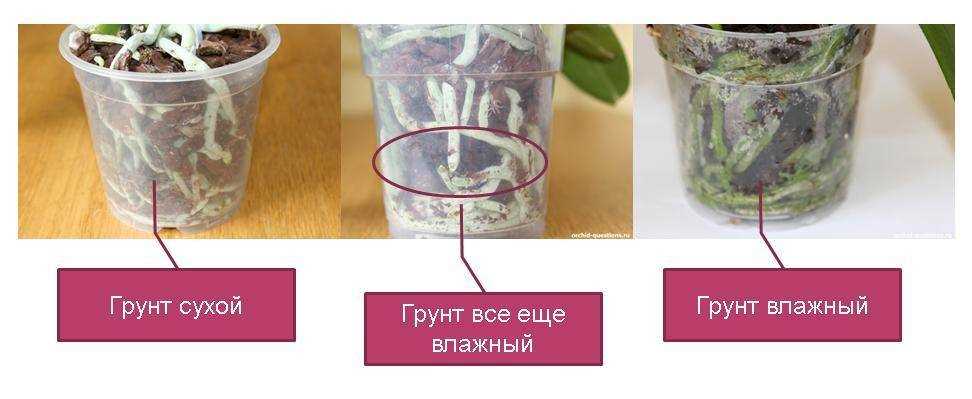
Калий является одним из важнейших элементов питания для орхидей. Он активно участвует в метаболических процессах и помогает растению преодолевать стрессовые ситуации, такие как пересадка, интенсивный рост или цветение. Поддерживая оптимальный уровень калия в почве, вы обеспечиваете здоровый рост и развитие орхидеи.
Для подкормки орхидей рекомендуется использовать специальные удобрения с умеренным содержанием калия. Подходящая концентрация калия в удобрении обеспечит питательный баланс для орхидеи и не приведет к переизбытку элементов. При выборе удобрения обратите внимание на его состав и убедитесь, что оно подходит для орхидей.
Калийное удобрение для орхидеи можно применять различными способами: через полив или спрей. Важно следить за инструкцией и не превышать рекомендованную дозу. Помните, что чрезмерное удобрение калием может негативно сказаться на здоровье орхидеи и привести к ожогам или другим проблемам.
Поддерживайте оптимальный уровень калия в почве, регулярно проверяйте состояние орхидеи и реагируйте на ранние симптомы недостатка или избытка калия. Следуйте рекомендациям по уходу за орхидеей и выбирайте качественное калийное удобрение, чтобы ваша растение радовало вас красивыми цветами и здоровым ростом.
Какое удобрение подойдет лучше всего?

Правильное удобрение является важным аспектом заботы о молодой орхидее. Какое удобрение подойдет лучше всего зависит от типа орхидеи и ее потребностей в питательных веществах.
1. Органические удобрения: Органические удобрения представляют собой природные вещества, такие как компост, перегной или растворенный навоз. Они обеспечивают орхидею всеми необходимыми микроэлементами и способствуют ее здоровому росту.
2. Минеральные удобрения: Минеральные удобрения содержат химические соединения, такие как азот, фосфор и калий. Они обеспечивают орхидею необходимыми питательными веществами, особенно во время активного роста или цветения.
3. Специализированные удобрения для орхидей: Существуют также специализированные удобрения, разработанные специально для орхидей. Они содержат оптимальное соотношение питательных веществ, специфических для орхидейные растений.
Важно помнить, что удобрение следует применять с осторожностью и в соответствии с инструкциями. Перед использованием удобрения рекомендуется ознакомиться с требованиями конкретного вида орхидеи, так как некоторые они могут иметь особые потребности в питательных веществах. Кроме того, следует учитывать сезон и стадию развития орхидеи, чтобы правильно дозировать удобрение.
Вопрос-ответ:
Как часто нужно поливать молодую орхидею?
Молодую орхидею нужно поливать примерно раз в 7-10 дней. Но необходимо следить за состоянием почвы и растения — если земля в горшке сухая, можно полить раньше.
Какой режим полива подходит для молодой орхидеи?
Для молодой орхидеи рекомендуется использовать метод обильного орошения. Это означает, что растение нужно полить так, чтобы влага пропитала всю почву грунта и вытекла через отверстия дна горшка.
Как выбрать подходящее удобрение для молодой орхидеи?
При выборе удобрения для молодой орхидеи рекомендуется обратить внимание на состав удобрения и наличие в нем основных макро- и микроэлементов, необходимых для развития растения. Также стоит учитывать возраст растения и его особенности.
Как часто нужно удобрять молодую орхидею?
Молодую орхидею рекомендуется удобрять каждые 2-3 недели в период активного роста, а в фазе покоя — один раз в месяц. Однако не забывайте о следовании инструкциям на упаковке выбранного удобрения, так как рекомендации могут отличаться в зависимости от бренда и типа удобрения.
Какое удобрение может быть оптимальным для молодой орхидеи?
Оптимальным удобрением для молодой орхидеи может быть удобрение с балансированным составом макро- и микроэлементов, а также с низким содержанием азота. Например, удобрение с соотношением элементов 10-30-20 будет хорошим выбором для стимулирования роста и развития молодой орхидеи.

